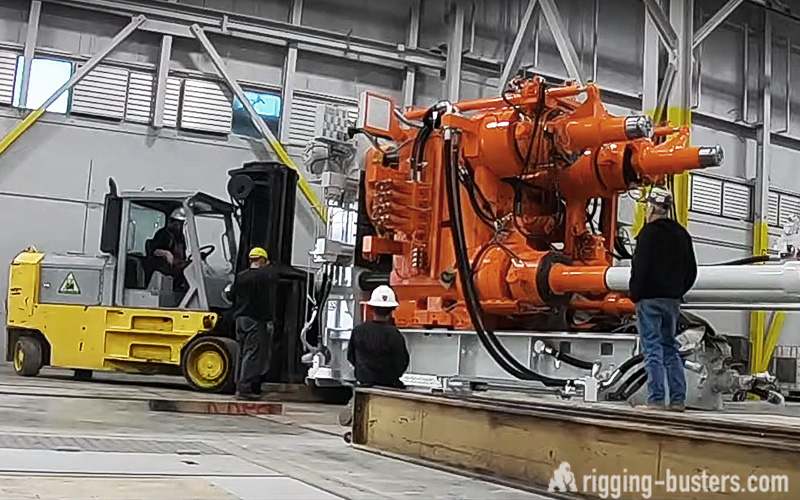Moving Mountains: Mastering Construction Equipment and Machinery Movers

Mastering the art of construction equipment and machinery movers is no small feat. In the complex world of construction, where large-scale structures stand tall and projects span far and wide, the importance of efficient and reliable machinery movers cannot be overstated. These specialized vehicles and equipment play a pivotal role in the success of construction projects, enabling the movement of heavy machinery, materials, and components with precision and ease.
From towering cranes to heavy-duty forklifts, construction equipment and machinery movers encompass a wide range of vehicles designed to handle the weight and size of construction machinery and materials. Whether it's excavators, bulldozers, or concrete mixers, these movers are the unsung heroes behind the scenes, carefully orchestrating the logistics of construction sites and ensuring that everything is in its right place.
Not only do construction equipment and machinery movers provide practical solutions for maneuvering heavy equipment, but they also contribute to increased productivity and reduced downtime. With machinery movers in toronto to transport machinery and materials efficiently, construction projects can stay on schedule and meet their deadlines, ultimately saving time and money in the process.
In this article, we delve into the world of construction equipment and machinery movers, exploring their various types and functionalities. We uncover the intricate balancing act required to move mountains in the construction industry and shed light on the vital role these movers play in the successful execution of projects. So, fasten your seatbelt, put on your hardhat, and join us as we journey into the fascinating realm of construction equipment and machinery movers.
Different Types of Construction Equipment
Construction projects require a wide range of equipment to carry out various tasks efficiently. Here, we will explore some of the different types of construction equipment commonly used in the industry.
Excavators: Excavators are heavy-duty machines equipped with a digging bucket or a hydraulic shovel at the end of an articulated arm. They are used for excavating and moving earth, rocks, and debris. With their versatility and power, excavators are essential for digging foundations, creating trenches, demolishing structures, and more.
Bulldozers: Bulldozers are formidable machines designed for pushing heavy materials, such as soil, rubble, and sand. They feature a large blade positioned at the front, which can be raised or lowered based on the task at hand. Bulldozers are commonly used to clear land, level surfaces, and create roads or pathways.
Cranes: Cranes are indispensable for lifting and moving heavy objects to elevated heights. These towering machines use a combination of cables, pulleys, and hydraulic power to maneuver loads with precision. Different types of cranes, such as tower cranes, mobile cranes, and overhead cranes, are used for various purposes, including erecting structures, placing heavy materials, and assisting in construction operations.
Each type of construction equipment serves a specific purpose and contributes to the overall efficiency and productivity of a construction project. Understanding the functionalities and capabilities of these machines is crucial for successfully navigating the complex world of construction equipment and machinery movers.
Key Considerations for Machinery Movers
When it comes to moving construction equipment and machinery, there are several key considerations to keep in mind. These factors play a crucial role in ensuring a successful and efficient moving process. Let's take a closer look at three important aspects that machinery movers need to consider.
Firstly, it is essential to assess the weight and dimensions of the equipment or machinery being moved. This information is crucial for planning the logistics and determining the suitable moving equipment required. By accurately measuring the weight and dimensions, movers can ensure that the appropriate lifting and transport equipment is used, reducing the risk of damage or accidents during the moving process.
Secondly, understanding the site conditions and layout is vital. Machinery movers must familiarize themselves with the terrain, potential obstacles, and any restrictions that may impact the moving process. This includes factors such as narrow doorways, staircases, or uneven surfaces. By having a clear understanding of the site conditions, movers can develop strategies and adapt their methods accordingly to overcome any challenges that may arise.
Lastly, proper communication and coordination are key considerations for machinery movers. It is crucial to establish effective communication channels with all parties involved in the moving process, including the client, project managers, and other contractors. This ensures that everyone is on the same page and working towards a common goal. Additionally, coordination with relevant authorities and obtaining necessary permits, if required, should also be considered to avoid any legal or regulatory complications.
By carefully considering these aspects, machinery movers can successfully navigate the complexities of moving construction equipment and machinery.
Best Practices for Moving Construction Equipment
When it comes to moving construction equipment, following best practices is essential to ensure a smooth and efficient process. Here are some key guidelines to keep in mind:
Careful Planning: Before moving any construction equipment, it is crucial to develop a detailed plan. Assess the size, weight, and dimensions of the machinery to determine the most appropriate method of transportation. Consider factors such as potential obstacles, route accessibility, and any necessary permits. Thorough planning will help avoid delays and maximize safety during the move.
Proper Equipment and Rigging: Choosing the right equipment and rigging is vital for a successful equipment move. Ensure that the machinery movers have the appropriate tools and machinery to handle the specific equipment being transported. Skilled operators and well-maintained rigging equipment are essential to guarantee safe and secure movement.
Operator Training and Safety: Moving construction equipment requires competent operators who are well-trained in equipment handling and safety protocols. Ensure that the moving team has certified operators with sufficient experience in handling similar machinery. Implementing safety measures, such as using proper protective gear and securing loads correctly, is crucial to prevent accidents and injuries.
By following these best practices, construction equipment and machinery movers can ensure a seamless and secure moving process. Prioritizing careful planning, using the right equipment, and maintaining a focus on safety will contribute to the successful relocation of construction machinery.

